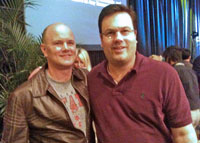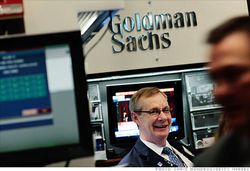This made me smile.
For more of these, and to make your own, here is the link.
 Mike Novogratz is the President of Fortress Investment Group, the first U.S.-based private equity/hedge fund manager to sell shares to the public. He joined Fortress in March 2002, and is responsible for the liquid hedge fund business, which includes running the Global Macro Funds.
Mike Novogratz is the President of Fortress Investment Group, the first U.S.-based private equity/hedge fund manager to sell shares to the public. He joined Fortress in March 2002, and is responsible for the liquid hedge fund business, which includes running the Global Macro Funds.
When we met earlier this year, I was impressed by his openness and perspective on the industry. It also comes through in the interview below.
In this revealing three-part interview, Novogratz shares his insights and reflections about:
1. How he earned his position.
2. The DNA, Risk Management, and Rules of Success in Macro Trading.
3. The significance of Instinct, Luck, Intuition, and a "Real Intelligence".
Mike Novogratz, President of Fortress Investment Group — Opalesque TV — Part 1.
Mike Novogratz, President of Fortress Investment Group — Opalesque TV — Part 2.
Mike Novogratz, President of Fortress Investment Group — Opalesque TV — Part 3.
Prior to joining Fortress, Novogratz spent 11 years at Goldman Sachs,
where he became a partner in 1998. He held the positions of president of
Goldman Sachs Latin America and Head of Fixed Income, Currencies and
Commodities Risk in Asia, where he lived from 1992 to 1999. Mr.
Novogratz received a B.A. from Princeton University, and served as a
helicopter pilot in the U.S. Army.
Fortress Investment Group
(NYSE: FIG) is a leading global
investment management firm. Total assets are around $41.6bn, with
$4.3bln in a global macro and a commodities based hedge fund.
 Mike Novogratz is the President of Fortress Investment Group, the first U.S.-based private equity/hedge fund manager to sell shares to the public. He joined Fortress in March 2002, and is responsible for the liquid hedge fund business, which includes running the Global Macro Funds.
Mike Novogratz is the President of Fortress Investment Group, the first U.S.-based private equity/hedge fund manager to sell shares to the public. He joined Fortress in March 2002, and is responsible for the liquid hedge fund business, which includes running the Global Macro Funds.
When we met earlier this year, I was impressed by his openness and perspective on the industry. It also comes through in the interview below.
In this revealing three-part interview, Novogratz shares his insights and reflections about:
1. How he earned his position.
2. The DNA, Risk Management, and Rules of Success in Macro Trading.
3. The significance of Instinct, Luck, Intuition, and a "Real Intelligence".
Mike Novogratz, President of Fortress Investment Group — Opalesque TV — Part 1.
Mike Novogratz, President of Fortress Investment Group — Opalesque TV — Part 2.
Mike Novogratz, President of Fortress Investment Group — Opalesque TV — Part 3.
Prior to joining Fortress, Novogratz spent 11 years at Goldman Sachs,
where he became a partner in 1998. He held the positions of president of
Goldman Sachs Latin America and Head of Fixed Income, Currencies and
Commodities Risk in Asia, where he lived from 1992 to 1999. Mr.
Novogratz received a B.A. from Princeton University, and served as a
helicopter pilot in the U.S. Army.
Fortress Investment Group
(NYSE: FIG) is a leading global
investment management firm. Total assets are around $41.6bn, with
$4.3bln in a global macro and a commodities based hedge fund.
Is Apple‘s magic still there?
Here is the product introduction video for the next generation of iPhone.
Here is a video that condenses Steve Jobs keynote address at Apple Developer’s Conference from two hours to less than five minutes. All the data, but perhaps not all the magic you’d expect.
Strangely, that sums up the response to the new iPhone 4 product
announcement. Here is a link to a live blog feed from the event. And here is a WSJ video questioning whether the iPhone is becoming a commodity product, rather than a consumer product.
So, are you getting one?
Is Apple‘s magic still there?
Here is the product introduction video for the next generation of iPhone.
Here is a video that condenses Steve Jobs keynote address at Apple Developer’s Conference from two hours to less than five minutes. All the data, but perhaps not all the magic you’d expect.
Strangely, that sums up the response to the new iPhone 4 product
announcement. Here is a link to a live blog feed from the event. And here is a WSJ video questioning whether the iPhone is becoming a commodity product, rather than a consumer product.
So, are you getting one?
Here is a picture that puts things in perspective. It overlays a representation of how big the oil spill is, now, over a map of where you live. Since I live in the Dallas-Fort Worth area, here is the result. Try it yourself by clicking the graphic.
The disaster in the Gulf started with an explosion on the BP operated Deepwater Horizon oil rig on April 20, 2010. Current estimates put the amount of oil being discharged from the broken well at above 1,050,000 US gallons per day. No one ever said cleaning up an oil spill was cheap: the U.S. government served BP with a hefty $69 million bill for the initial costs of contending with the worst oil disaster in U.S. history. Here is a link to a site devoted to the spill and its fallout.
Reading about it is one thing … However, seeing what is happening is often a better way to gauge reality. So judge for yourself; here is a live stream from an under-water "Spill-Cam".
It comes from PBS.
Here is a picture that puts things in perspective. It overlays a representation of how big the oil spill is, now, over a map of where you live. Since I live in the Dallas-Fort Worth area, here is the result. Try it yourself by clicking the graphic.
The disaster in the Gulf started with an explosion on the BP operated Deepwater Horizon oil rig on April 20, 2010. Current estimates put the amount of oil being discharged from the broken well at above 1,050,000 US gallons per day. No one ever said cleaning up an oil spill was cheap: the U.S. government served BP with a hefty $69 million bill for the initial costs of contending with the worst oil disaster in U.S. history. Here is a link to a site devoted to the spill and its fallout.
Reading about it is one thing … However, seeing what is happening is often a better way to gauge reality. So judge for yourself; here is a live stream from an under-water "Spill-Cam".
It comes from PBS.
BP said Saturday that its latest attempt to stop the gushing oil well in the Gulf of Mexico was unsuccessful, and the effort, known as a “top kill,” was being scrapped in favor of yet another maneuver to stem the flow spreading into the waters.
Sometimes, an ounce of prevention is worth a pound of cure.
BP said Saturday that its latest attempt to stop the gushing oil well in the Gulf of Mexico was unsuccessful, and the effort, known as a “top kill,” was being scrapped in favor of yet another maneuver to stem the flow spreading into the waters.
Sometimes, an ounce of prevention is worth a pound of cure.

The numbers are incredible. Goldman Sachs just revealed in an SEC filing that its traders made money on every single
trading day last quarter, a record for the firm. Net revenue for
trading was $25 million or higher in all of the first quarter’s 63
trading days with 35 of those days bringing in more $100 million.
Even if you had a 95% likelihood of a winning day, you would have
only a 3.9% chance of doing it 63 trading sessions in a row.
Does a Perfect Trading Quarter Score One for the Rigged-Market Theory?
Whatever the cause of the perfect quarter, it comes as part of a
pattern. Goldman Sachs only recorded 11 loss days in the prior 12 months. So while some luck is
involved in stringing together a perfect Quarter, the trend of success does not seem to be a fluke.
It gets more curious, because it wasn't just Goldman. Bank of America, Citigroup, and JPMorgan each also recorded a perfect quarter of trading profits. What are the odds of that happening? Apparently, pretty high under their current operating conditions.
When the government is on a mission, you may not like the policies … but as an investor, you fight it at your peril. More simply put, don't fight the Fed.
It looks like the Banks figured that out.
Goldman figured it out sooner.